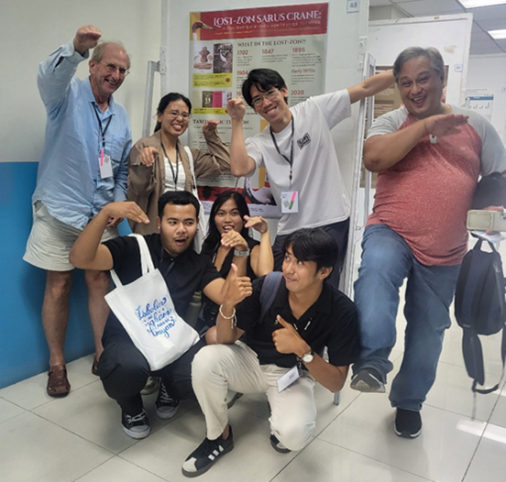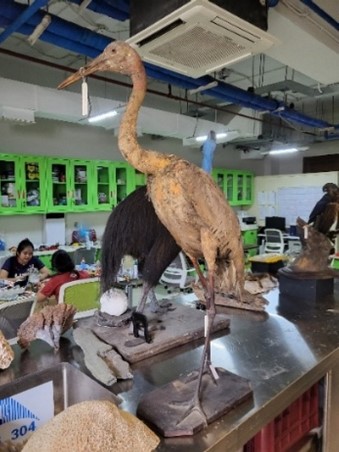Celebrating 25 Years of Regional NRM
The 9th National Natural Resource Management Knowledge Conference, held September 8–12 in Cairns, marked a significant milestone, 25 years since Australia adopted the regional natural&...

The Philippine Sarus Crane Grus antigone luzonica, known as Tipol in Filipino, went extinct in the 1970s. Twenty-five years before, it was a common bird in rural Luzon. What prompted its extinction, after several thousand years living alongside farming communities, is still a matter of speculation but following Philippine independence from the United States of America in 1946, its demise was rapid and absolute.
Community attitudes in Asia are changing though and similar Sarus extinctions in Thailand and Vietnam are being reversed by popular reintroduction projects. If this change in rural attitudes towards birds that live and forage alongside rural communities is paralleled in the Philippines, a similar reintroduction could now be on the cards. Against this backdrop, the annual symposium
organised by the Association of Systematic Biologists of the Philippines (ASBP) in Manila brought together some key researchers, including Adjunct Professor Tim Nevard (the author) of The Cairns Institute (TCI) and Professor Juan Carlos Tecson Gonzalez of the University of the Philippines Los Baños (UPLB).
Recent genetic work indicates a close affinity between Tipol and Australian Sarus (G. a. gillae). Although it currently looks like the best genetic ‘fit’ for reintroduction is from Queensland, there is still potential that the South-east Asian subspecies (G. a. sharpii) could be an alternative. Final confirmation will therefore require analysis of more Tipol specimens, so the author and Professor Gonzalez inspected specimens at the University of Santo Tomás (UST) museum and the National Museum of Natural History (NMNH) in Manila.
To increase the certainty around the genetic relationships of Tipol, as many specimens as possible are to be tested for their genetic affinities with both Australian and SE Asian Sarus.
Alongside this genetic work is equally important community engagement. This will need to occur in the vicinity of each of three potential reintroduction sites, which are currently under investigation by Jimuel Piñafiel (a student of Professor Gonzalez), who also presented a poster at the symposium. The author was able to visit one of these sites at Lalaguna Marshland, near Lopez, Quezon, where he, Stella and Jürgen Freund met officers and members of the Municipal Council. All expressed early enthusiasm for the potential project at Lalaguna, where one of the last observations of Tipol was made.
Next steps are: (i) confirmation of the appropriate source of birds for reintroduction; (ii) community engagement around the potential reintroduction sites and nationally; (iii) preliminary discussions with Philippine and source authorities and NGOs; (iv) selection of a preferred reintroduction site; (v) preparation and lodgement of a comprehensive costed project plan; (vi) project approval; (vii) fundraising and ongoing engagement for the
reintroduction; (viii) acquisition and translocation of eggs or birds to a specialised purpose-built rearing facility in the Philippines; (ix) rearing and preparation for release under strict biosecure
conditions; (x) release and monitoring over a three to four year period - until a sustainable wild population can be established.
Images: Credit T.Nevard
JUNE 2025



The 9th National Natural Resource Management Knowledge Conference, held September 8–12 in Cairns, marked a significant milestone, 25 years since Australia adopted the regional natural&...
The Tropical North Queensland Drought Resilience Hub's Sustainable Aboriginal and Torres Strait Islander Enterprise Program (SATSIE), in collaboration with the North Australian Indigeno...
A special visit for students from AFL Cape York House for Girls (AFLCYHG) to the Local Indigenous Food Enterprise Services (LIFES) garden was facilitated through The Tropical North Quee...
James Cook University (JCU) 2025 cohort of Master of Global Development (MGD) students visited Mossman recently to observe and engage with a community in transition from sugar to a mode...
Four members of the Far North Queensland (FNQ) Connect team embarked on an eventful journey around Cairns city - but this was no ordinary outing. The colleagues were taking part in Spi...
During a recent visit to Waibene (Thursday Island), Jen McHugh toured the community centre Buai Mudh, meaning Family House, and met with board members of the Mura Kosker Sorority who op...
James Cook University (JCU) researchers from Cairns and Townsville joined an in-person forum at the JCU's Bada-Jali campus on September 23 and 24 for a university-wide plan to progress ...
The Whitsundays provided a valuable platform for producers, industry and community to share knowledge, compare practice, and explore new approaches that support resilience to a more var...
© 2025 The Cairns Institute | Site Map | Site by OracleStudio | Design by LeoSchoepflin